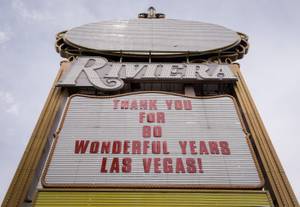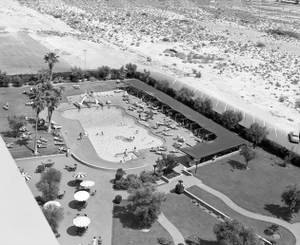When community members confront a powerful behemoth like the Las Vegas Convention and Visitors Authority, suggesting, even demanding, that the legendary Riviera now owned by the LVCVA not be razed, it’s practically begging for a humorous retort.
Even the illustrious original Penn Station, a monumental and architecturally celebrated historic New York City landmark, was demolished to build Madison Square Garden, this despite international outcry that ended up prompting new laws about preservation.
When it comes to the pricey real estate of the Las Vegas Strip, preservation and progress make for disagreeable bedfellows. But what if they didn’t? What if some of the mid-century structures—the Sands, the Dunes, the Desert Inn—had remained impeccably preserved, and preservation was the norm, if not the main attraction?
A petition on change.org proposing that the LVCVA reconsider demolition plans and save the Riviera (signed by fewer than 350 people as of press time) will likely go nowhere. But the idea of preservation isn’t so ridiculous that it hasn’t been considered by advocates and some longtime locals. After all, had Las Vegas openly celebrated its rich history, the skyline would look completely different, less forced and less bombastic, with a level of organic urban sophistication.
“No one as yet has effectively brought back the classic vintage Las Vegas hotel vibe that people crave in terms of visuals and substance,” says-Mary-Margaret Stratton, preservation advocate for mid-century modern architecture. Stratton, who is former executive director for Atomic Age Alliance, would like to see the LVCVA consider adaptive reuse for the Riviera’s original nine-story tower, possibly creating boutique hotel rooms for VIP convention guests, unique meeting spaces, and/or permanent displays of the LVCVA’s robust and legendary photo collection.
Alan Hess, architecture critic and author, who’s written and lectured extensively on the value of mid-century Las Vegas architecture, suggests the possibility of preservation, adding that the Riviera complex includes structures that were designed by major architects Roy France and Son, Welton Becket and Martin Stern Jr. and date back to the “heyday” of the Strip.
“They’ve been added to, screened off and remodeled a lot,” Hess says. “But the original building and the earliest wings still boast the classic, clean lines of mid-century modern.”
Moreover, he explains, “There’s no question that parts of the Riviera complex could be incorporated into a new project and restored. That would keep alive an integral part of the Strip’s character. The LVCVA could also make a major statement about sustainability, which is so important today—the greenest building is the one that is already standing.”
Lynn Zook, creator of ClassicLasVegas.com, shares Hess’ sentiment: “Perhaps it is time to stop telling Las Vegans their history is disposable,” she says. “Who better to do that than the LVCVA, home to the archive of the Las Vegas News Bureau, which helped make the Riviera famous. People who truly love the Las Vegas Strip are tired of losing classic hotels that are tied to that Las Vegas era.”
Maybe that’s what led to the opposition to imploding the Riviera, the Strip’s first high-rise, designed in a modernist Miami style and built during the swank ’50s (even though the LVCVA paid a hefty $185 million for it).
“A lot has been lost,” says local Darlene Dalmaceda, who’s promoting the change.org petition to save the Riviera (actually begun by a California resident). “We only preserve signs. Why can’t we preserve buildings?”










